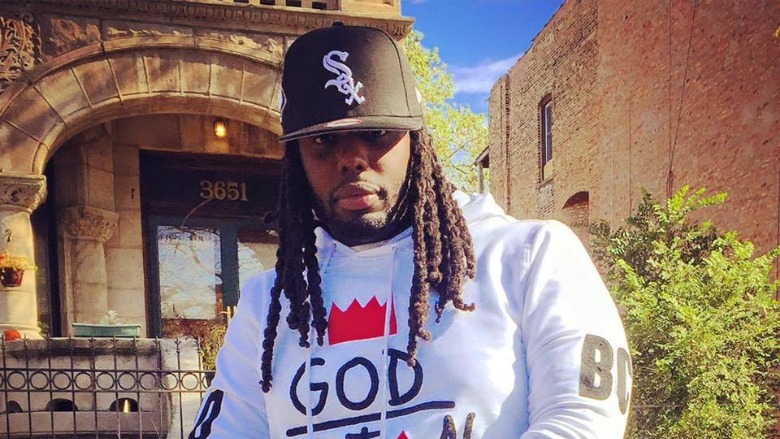
Facebook Zack Stoner.
A popular Chicago independent music journalist was shot dead in his hometown and a press freedom group is urging police to investigate whether he was targeted because of his work. The Committee to Protect Journalists “condemned” the killing of Zack Stoner, who was fatally shot on May 30. No one has been arrested in his death.
Stoner ran the YouTube channel “zacktv1,” posting interviews with Chicago hip hop stars and others in his community, focusing his reporting on the lives of people in the city’s neighborhoods who rarely get coverage from the mainstream media.
“Authorities should thoroughly investigate the murder of Zachary Stoner, including whether his journalistic work was the motive for his death,” Alexandra Ellerbeck, CPJ’s program coordinator for North America, said in a statement on June 6. Police spokesman Anthony Guglielmi told WGN-TV detectives are working to determine if Stoner was the target of the shooting and if there is a connection to his journalism.
The CPJ is a non-profit organization that promotes press freedom around the world, defending “the right of journalists to report the news without fear of reprisal.” The CPJ said, “Killings of journalists in the United States are relatively rare. At least seven journalists have been killed in the country in direct relation to their work since CPJ began documenting cases in 1992. CPJ reported in 1994 on several unsolved murders of American immigrant journalists in the 1980s and 1990s.”
Here’s what you need to know about Zachary ‘Zack’ Stoner:
1. Stoner Was Shot in the Head While Driving After Leaving a Concert, Crashed His Jeep & Died at a Local Hospital
Zack Stoner left the Refuge nightclub early Wednesday morning, May 30, after attending a rap concert there, police said, according to the Chicago Tribune. He was driving his Jeep down Clark Street in the South Loop neighborhood about 1:30 a.m. when another vehicle pulled alongside him and opened fire.
Stoner was shot in the head and neck and crashed his Jeep into a light pole. He was rushed to Northwestern Memorial Hospital in critical condition and was pronounced dead about 4:30 a.m. A video recorded by a witness shows three people getting out of the car that opened fire on Stoner, with someone yelling, “let’s go,” before getting into a third vehicle and driving off. The vehicle used in the shooting was left at the scene.
According to the Committee to Protect Journalists, “Detectives from the Chicago Police Department are still investigating Stoner’s murder, a spokesperson told CPJ, and are reviewing possible pod-camera footage of the incident. Officer Norma Pelayo, a department spokesperson, told CPJ that no suspects are in custody.”
His friend, Phor Robinson, told WGN-TV, “I’m hearing stories like they may have been mad at him because he did interviews with certain rappers. But that’s not his fault for him doing his job. I don’t know why anyone would attack Zack and shoot him. He’s not that type. He shows love to everybody in Chicago.”
Robinson added, “I don’t know if they was personally shooting at him, or if it was somebody he was with. I don’t know what it was. All I know is my friend is gone.”
Activist and mayoral candidate Ja’Mal Green offered a $1,000 reward for information, tweeting, “My friend.. WOW! Seen a few times in the last few weeks. Was just about to do an interview for my campaign! I want to offer an award for information leading to the arrest of the suspects. This is sickening!”
His cousin, Lamarr Stoner told the CPJ, “He was going to different hoods, talking to rappers in places the media can’t go, filming and recording, and making sure the word got out on the street and around the world about what was going on.”
2. He Was a Powerful Voice in Chicago & Called Himself the ‘Hood CNN’ & ‘the Best Interviewer in the World’
Zack Stoner and his “zacktv1” YouTube channel and social media accounts were well known in Chicago and he was a powerful voice in the community, shedding light on stories that were rarely covered by the mainstream media, according to the Committee to Protect Journalists and those who knew him. He had more than 180,000 subscribers on YouTube and thousands of followers on Twitter and Instagram. In his Twitter profile, Stoner wrote, called himself, the “Best Interviewer in the world,” adding, “I’ve been to some of the most dangerous hoods in America with faith in God and a Camera.”
Stoner’s cousin, Lamarr Stoner told the CPJ, “He was going to different hoods, talking to rappers in places the media can’t go, filming and recording, and making sure the word got out on the street and around the world about what was going on.”
Stoner, who graduated from Corliss High School in the Pullman neighborhood, was profiled by the Chicago Defender in April, and he told the news outlet, “A lot of people respect what I do. I’m the ‘Hood CNN.’ A news station is one-sided. They’ll get your full interview, but they will cut and edit and put whatever they want out. Whatever you say to me will get put out in full no matter if it’s positive or negative. I show both sides.”
He told the Defender, “I wanted to show the world the other side of Chicago. Back when I was growing up, we had Common and Kanye West. Those are great brothers and great entertainers, but I didn’t think they represented Chicago the way that I’ve seen Chicago. I wanted to show the world what the other side of Chicago looks like … our culture––the way we dress, what we eat, how we talk, how we walk.”
Morgan Elise Johnson, co-founder and creative director of The Triibe, a Chicago-based publication, told the CPJ she met with Stoner and his business partner, Tony Woods, in April. She told the CPJ, “His voice was so powerful in the hood, and I don’t know if that power had something to do with his death.”
3. Stoner Helped Give Attention to the Rapper Chief Keef, Who Was Shot at in NYC on June 2, Early on in His Career
Stoner began posting videos on YouTube back in 2009, but his profile had grown significantly in recent years. The Chicago Defender’s Charles Preston wrote about Stoner in April:
ZackTV1’s oldest footage is a candid 18-second clip entitled “Summer Camp 09,” a casual vignette of a group of young men rapping and beatboxing. It’s oddly fitting that this is the channel’s first video because it serves as a precursor for Stoner’s content––raw, unfiltered, and centered on young Black men. View ZackTV1’s timeline in chronological order and one can tell that Stoner started taking a more focused approach with his journalism. Candid videos turned into premeditated interviews. The random characters freestyling changed into full-fledged rap music videos. His coverage became more deliberate than accidental.
Stoner’s efforts to unapologetically show the realities of his community does raise a question of ethics and comes with a great deal of pushback from many Chicagoans, as well as traditional journalists.
Stoner documents what others neglect and repeatedly interviews personalities who many had hoped would never grace a camera. His videos are not fluffy, glitzy, and sentimental documentary shorts; on the contrary, they are more like visceral punches to the gut that can leave you either inspired for change or disturbed by reality.
In 2012, Stoner interviewed Chief Keef, who was a teenager and early in his rap career, helping to give him a spotlight. Chief Keef was shot at outside of the W Hotel in New York City on June 2.
“Chief Keef was made into the symbol, and what some would say the scapegoat, of the violence that plagued Chicago from 2012 to 2014. Stoner could never have guessed that Chief Keef would be so famous to the point that he is the target of protests by Father Pfleger, and arguably the most influential rapper of this current era of hip-hop,” Preston wrote in April, before Chief Keef was shot at and Stoner killed. There is no indication the two shootings are connected.
4. He Received Death Threats After Posting Videos About the Death of Kenneka Jenkins, a Chicago Teen Who Was Found Dead in a Hotel Freezer, Leading to Conspiracy Theories
Stoner received death threats last year while reporting on the death of Kenneka Jenkins, a Chicago teen found dead in a walk-in freezer at a suburban hotel following a party with friends, according to the Committee to Protect Journalists. Jenkins’ death led to many conspiracy theories, but authorities eventually ruled it an accident.
In videos on his YouTube page, Stoner talked about the threats he received. He said in October 2017, a woman called him and warned him to “leave the case alone … leave it alone for your safety.” Stoner said in a video he was not going to post interviews related to the case because his house was broken into. He said camera gear was stolen and he received other threatening phone calls and emails. He eventually posted interviews with Jenkins’ family and friends in November.
5. Stoner Was Known as a Peacemaker, Often Interviewing Rival Gang Leaders & Offering Them an Opportunity to Settle Their Differences
While some people criticized Stoner for talking to gang members and giving them a platform, he, his business partners and supporters said he was really a “peacemaker” who was trying to stop violence in Chicago by helping to settle differences, according to the Committee to Protect Journalists.
“Stoner was about support and healing, not just reportage—he gave voice to Chicagoans who had none, quashed beefs between artists and cliques, and strove to create positive change in resource-deprived communities burdened by a history of systemic racism. It’s impossible to count how many people he touched with his work, but after he was shot dead at age 30 on Wednesday morning in the South Loop, it seemed like all of Chicago began grieving,” Leor Galil wrote in the Chicago Reader.
“If you study ZackTV’s interviews, you’ll notice that at the end of them, I often ask ‘What can we do to resolve the violence in Chicago?’ But a lot of young men feel that their hood will look down on them if they wanted to fix the problem,” Stoner told the Chicago Defender in April, a month before his death. “A lot of people may look at these individuals like they’re thugs, ghetto hoodlums, or nobodies. But to me, I look at each artist as a human being that is stuck in this box that they are trying to get out. When you’re in the hood–ghetto, urban communities, whatever you want to call them–it’s a way of life but also survival tactics. Never judge a book by its cover. Never look down on the next man.”




